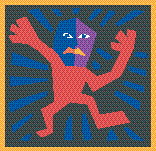Fiction Terms
dae4 spring 2005

Analysis of a story
Read the story closely Read it once for leisure, a second time making marginal notes. Consider the overall intent and subject of the story. How does it make you feel? What do you suppose the author's intent was?
Discussion Points
Form: How well does it fit Freytag's triangle? Consider the complication, crises, conflicts, climax, resolution. Identify any dilemmas and flashbacks.
Characters and Setting: Describe the personality of the protagonist and any antagonists using the five methods of development. Are the characters round or flat?
Point of View: Determine the voice (1st person, 2nd person, 3rd person) as well as the focus (omniscient or limited). Consider also the psychic distance variations.
Language: Consider Diction (Are the words formal or informal, general or specific? Identify any patterns to connotations); Figurative Language (Identify any metaphors, personification, parallelism); Symbols (Identify the public and the private symbols).
Interpretation: Look over your Discussion Points. In order to evoke the tone, theme, and the ultimate meaning of the story, a writer uses these items to initiate the imagination. The theme is usually a particular way of looking at the experiences of the characters and it relates to how humans may best live their lives. Remember that the purpose of art is both to delight and to educate. The value of a story is based on the truths it tells us about life and existence.

Narrative Terms:
Not all these terms are limited to fiction. Some will appear again in poetry analysis.
*Protagonist: The central character of a story
*Antagonist: The characters, actions, or forces that create conflict for the protagonist
*Story and Plot: Story is the chronological events as conceived by the writer. Plot is how those events are presented to a reader.
*Complication: the onset and development of the major conflict
*Scene: a highly detailed, unified, and described experience in a plotline, usually including dialogue, where dramatic time equals or exceeds reading time.
*Summary: Narrative bridges between scenes. Actions are summarized and dramatic time is less than reading time.
*Crisis Points: Moments of high tension, "turning points," where there is a possibility that the antagonistic forces will overwhelm the protagonist's desire to succeed
*Climax: The "Moment of Being." The scene when all actions become clear and the complication that created the conflict is completely understood by the protagonist. Sometimes the goal is reached, the struggle overcome; other times the conflict is only understood so well that a solution becomes visible.
*Resolution: The end of the story where balance is returned and the complications are resolved
*Theme: How the accomplishments or learning of the protagonist can be related to the struggles of humans to survive, grow, and change

*Character Development:
Characters are the most obvious development through resonance. Readers learn to judge them by the following methods:
Actions: What characters do and their mannerisms
Appearance: What characters look like (both physical and dress)
Speech: What characters say and how they say it
Thoughts: What characters think and how they think it.

Setting Development
*Setting: This is the mood, location, and details of the story environment. The Significant Details are those specific terms that the narrator focuses on including nature, structures, cultures, and locations.
* Mood: Colors, details, shapes, sounds repeated or mentioned
*Point of View: The choice of what to show by an author. Usually, the choices are 1st person: Narrator tells story through the thoughts of the character; 2nd person: the narrator tells the story through the reader as "you;" or the variations of 3rd person: Unlimited perspective (many pov's), Limited perspective (one or two pov's), or Objective perspective (no pov's)
*Imagery: Intensely detailed word pictures meant to create strong emotional responses. Very often imagery is consistent, meaning particular images are repeated in order to achieve a greater effect.
